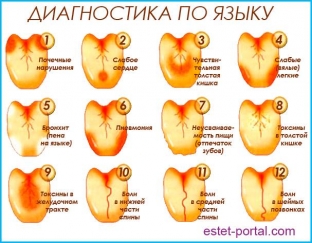It is the language that has long been considered an indicator of the state of human health, because it is able to reflect the state of all organs and systems. Sometimes language changes appear before the first symptoms of the disease. In an absolutely healthy person, the color of the tongue is pale pink, without plaque, cracks and inflamed papillae. For example, a red tip of the tongue indicates that there are heart problems, and a brownish coating indicates digestive problems. Learn how to diagnose by tongue and identify the disease in time.
Diagnosis by language: how to identify an ailment
When examining the tongue, pay attention to:
- character of plaque in different areas of the language;
- language color;
- tongue mobility;
- the shape and nature of the surface;
- education in – aphthae, blisters, papillomas. The diseased organ is indicated by the place of their deployment.
If such changes become noticeable at the root of the – this indicates problems in the work of the intestines, the tip of the tongue is responsible for the heart. The zone to the left of the tip indicates problems of the left lung, and to the right – right lung. Kidney disease is indicated by changes in the area of the left side of the tongue, closer to the root.

Tongue color, tongue coating pattern and tongue size
Language color
As for color, if red spots appear on the tongue against a generally pale background, this may be a sign of problems with the respiratory system. A glossy red tongue indicates poor liver function and toxins in the body. If during the examination you notice that the tongue is purple – this is a sign of severe blood stasis, and the tongue can also take on such a shade in a very hot season.
The red tip of the tongue indicates a malfunction of the heart. A brown tint indicates digestive problems. Grayish patina – a sign of iron deficiency in the body.
The nature of the plaque in the language
The tongue turns pale when the body is weakened, for example, with anemia, malnutrition or chronic fatigue. With gastritis with high acidity and enterocolitis, the tongue is completely covered with a white coating and slightly enlarged.
A yellowish coating indicates problems with the pancreas and liver.
If you can see an uneven strip along the tongue – this indicates problems with the spine.
Language size
A swollen tongue is indicative of problems that are associated with a dysfunction of the thyroid gland (hypothyroidism).
To detect irregularities in the work of the heart – stick out your tongue and try to see its inside. If the veins on the back of the tongue are very swollen, this most likely indicates heart failure.
When many furrows and reliefs can be seen on the surface of the tongue – this signals a malfunction in the pancreas and kidneys. Also, tongue diagnosis is carried out when there are cracks on the surface and, depending on their location, asthma, diabetes and other diseases are detected.
Only a qualified specialist can make an accurate diagnosis, and any changes in the color of the tongue, its size and the nature of the plaque are only an occasion to pay attention to the state of your health and seek help from a doctor.






Add a comment